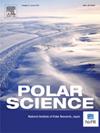Predictability and applicability evaluation of winter temperatures in China based on Eurasian Arctic sea ice concentrations in autumn
IF 1.5
4区 地球科学
Q3 ECOLOGY
引用次数: 0
Abstract
The current trends of a warming Arctic and a reduction in Arctic sea ice lead to remote effects on climate anomalies in mid-latitude regions. We investigate the predictability of winter temperatures in China using an empirical regression model to forecast those temperatures based on the Eurasian Arctic sea ice concentration (SIC) in autumn and explore the applicability of this prediction method. Result shows the September Eurasian SIC achieves a highly skilled seasonal prediction of winter temperature anomalies in China. A cross-validated hindcast for the leading principal component of winter temperatures in China using the September SIC within the region (40–150° E, 65–85° N) yields a correlation skill of 0.47 from 1979 to 2018. This suggests that 22% of winter temperature variance in China can be predicted by the Eurasian SIC two months in advance. Winter temperature hindcast/forecast results indicate that September SIC demonstrates a positive temporal anomaly correlation coefficient at most stations in China, with a spatial average reaching 0.32/0.29. However, its forecasting ability for the magnitude of temperature anomalies is relatively weak. Lower tropical Pacific Ocean temperatures, a weak polar vortex, and a strong Ural blocking (UB) in autumn could improve Eurasian SIC's predictive performance.
基于欧亚北极海冰秋季浓度的中国冬季气温可预测性及适用性评价
目前北极变暖和北极海冰减少的趋势导致对中纬度地区气候异常的远程影响。基于欧亚北极海冰浓度(SIC),利用经验回归模型对中国冬季气温进行了预测,并探讨了该预测方法的适用性。结果表明,9月份欧亚大陆SIC对中国冬季气温异常具有较好的季节预测能力。利用区域(40-150°E, 65-85°N) 9月SIC对中国冬季气温的主成分进行交叉验证的后验,得出1979 - 2018年的相关技能为0.47。这表明,中国冬季气温变化的22%可以通过欧亚SIC提前两个月进行预测。冬季气温预报结果表明,9月份中国大部分站点的SIC时间异常相关系数均为正相关,空间平均值为0.32/0.29。但其对气温异常幅度的预测能力相对较弱。较低的热带太平洋温度、较弱的极地涡旋和秋季较强的乌拉尔阻塞(UB)可以提高欧亚大陆SIC的预测性能。
本文章由计算机程序翻译,如有差异,请以英文原文为准。
求助全文
约1分钟内获得全文
求助全文
来源期刊

Polar Science
ECOLOGY-GEOSCIENCES, MULTIDISCIPLINARY
CiteScore
3.90
自引率
5.60%
发文量
46
期刊介绍:
Polar Science is an international, peer-reviewed quarterly journal. It is dedicated to publishing original research articles for sciences relating to the polar regions of the Earth and other planets. Polar Science aims to cover 15 disciplines which are listed below; they cover most aspects of physical sciences, geosciences and life sciences, together with engineering and social sciences. Articles should attract the interest of broad polar science communities, and not be limited to the interests of those who work under specific research subjects. Polar Science also has an Open Archive whereby published articles are made freely available from ScienceDirect after an embargo period of 24 months from the date of publication.
- Space and upper atmosphere physics
- Atmospheric science/climatology
- Glaciology
- Oceanography/sea ice studies
- Geology/petrology
- Solid earth geophysics/seismology
- Marine Earth science
- Geomorphology/Cenozoic-Quaternary geology
- Meteoritics
- Terrestrial biology
- Marine biology
- Animal ecology
- Environment
- Polar Engineering
- Humanities and social sciences.
 求助内容:
求助内容: 应助结果提醒方式:
应助结果提醒方式:


